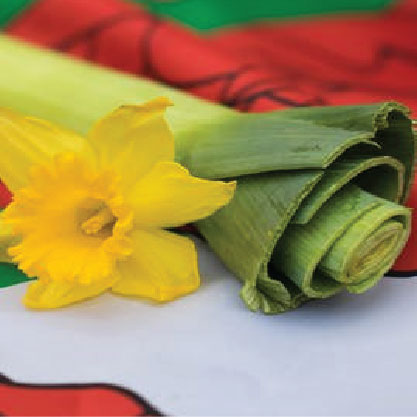ST DAVID’S DAY – DYDD GWYL DEWI.
Welsh people celebrate the life of St David on March 1st by wearing a daffodil or leek and many children also wear traditional costumes to school. There are church services and the national flag is displayed prominently. Although St David’s Day is not a public holiday, there is a National St David’s Day Parade held in Cardiff.
THE NATIONAL COSTUME OF WALES;
The traditional Welsh National costume for Women in particular, originates from the late 18th century woolen bedgown worn by women in rural areas of Wales. This was worn over a striped flannel petticoat with an apron, shawl and kerchief and became associated as a particularly Welsh way of dressing for Women when going to markets or attending special occasions. During the 1830’s, many people saw the increasing industrialisation of Wales as a threat to its traditional identity and culture.
One these who was particularly active in taking measures to preserve and promote these values, was Augusta Hall (Lady Llanover) heiress to the Llanover estate, near Abergavenny whose essay on “The Advantages resulting from the Preservation of the Welsh language and National Costume of Wales” won first prize at the 1834 National Eisteddfod.
Lady Llanover also made extensive research and commissioned illustrations on the costume, she even issued her staff with national dress uniforms and organised balls at which her guests were encouraged to wear it. The iconic Welsh costume does not appear until the late 1840s and may have developed from a combination of the tall, ladies riding hat and of the hats of men worn during that period (as appears in the Llanover prints). As a means of further promotion, many artists then produced prints and later photographers produced popular postcards including the uniform to enhance the increasing tourism trade. Also thousands of Welsh dress dolls were manufactured for gifts and souvenirs. The men’s costume consisted of a waistcoat, woollen jacket, neckerchief, breeches, woollen stockings and a black felt hat.
THE LEEK AND THE DAFFODIL;
According to legend, St David advised Welsh soldiers to wear leeks on their helmets to identify themselves during a successful battle against the Saxons in a field full of leeks. There is a 16th Century reference to the emblem of Wales being the leek in Mary Tudor’s account book and Shakespeare refers to Fluellenas being a good countryman of Wales by wearing a leek.
The Myddfai Physicians of Carmarthenshire used leeks as a cure for a variety of illnesses and over the years it has seen a variety of uses: a treatment for battle wounds, a means of keeping away evil spirits and if placed under a pillow by young maidens, as a means of foretelling their future husbands as well as assisting in easing the pains of childbirth. Welsh soldiers wear a leek in their caps on Saint David’s Day and there is a tradition for the youngest recruit of the Welsh Guards to eat a large raw leek on St David’s Day.
The leek is often substituted for the daffodil, probably as a result of the similarity of their names in Welsh. The Welsh for leek is Cenhinen, while the Welsh for daffodil is Cenhinen Bedr. Hence the daffodil has become adopted as the second emblem of Wales.



